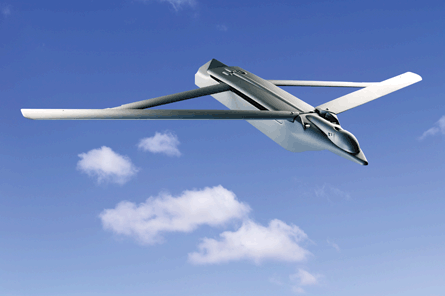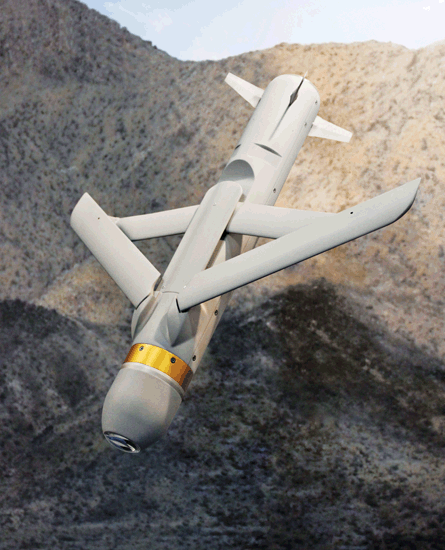At this year's show, weapons manufacturer MBDA is unveiling the outputs of its first annual Concept Visions exercise, an analogue of automotive manufacturers' concept cars that is intended to brainstorm ideas for the guided weapons of the future.
The exhibits at MBDA's stand also include three small weapons: the Diamond Back range-extension wing assembly, the hand-launched Tiger tactical grenade system, and the Saber small air bomb.
Development of each of these weapons was led by the company's US arm, MBDA Incorporated. Founded in 1986, MBDA Incorporated was known as Alenia Marconi Systems until a January 2002 reorganisation that followed the creation of the parent via a merger of Matra BAe Dynamics, EADS-Aerospatiale Matra Missiles and Alenia Marconi Systems. MBDA is today owned by BAE Systems, EADS and Finmeccanica.
 |
|---|
© MBDA |
The company characterises Concept Visions, launched in late 2009, as an attempt to "unlock the latent creativity within MBDA" to sketch a picture of what guided weapons might look like in 20 years' time, thereby determining long-term goals for its process of incremental product development. The first Concept Visions exercise was specifically targeted at "improving the capability of infantry soldiers".
Towards its stated aim to "inspire our customers, suppliers and ourselves", MBDA included every member of its workforce - from engineers to cooks and catering staff - in a call for ideas, which it issued in February. The incentives to inspire staff to get their ideas off their chests ranged from free Farnborough tickets to cash prizes, of which around €10,000 ($12,500) would be distributed.
Within two weeks of the call going out, employees returned a total of 250 system and technology ideas, which together covered 80 sides of A3 in eight-point text. These were whittled down to "a family of core ideas around one concept".
A team of 20 engineers then worked for 10 weeks to transform this into what MBDA terms a "showcase system with ambitious performance representative of the 2030-plus timeframe". This system is being presented in concrete form at the show, with tactile models on display.
SOLID MODEL
To bring Concept Visions to fruition, MBDA deployed rapid development techniques adapted from its Fire Shadow loitering munition and Black Shadow unmanned vehicle programmes. These included interviews with European soldiers to "identify issues with current capabilities"; a focus on "experience and effects", facilitated by the elimination of formal requirements; and work with "designers from other domains" to develop low-cost, ergonomic and simple design principles.
MBDA's UK, French, Italian and German arms were all involved in the Concept Visions initiative, which was aimed at providing a response to those nations' demand for low-cost fire support for dismounted infantries operating in cluttered, congested urban environments where mortars cannot be used and accuracy - at extended ranges - is prioritised.
Crucial to the process was a meeting with the UK's Welsh Guards anti-tank platoon, which had recently returned from Afghanistan and was in the process of transforming itself from anti-tank platoon to fire-support group.
 |
|---|
© MBDA |
Having pursued Concept Visions on a clean-sheet basis, MBDA sought to develop outputs that avoided duplicating capability and were platoon-level, holistic and net-capable (but not net-reliant).
Given a 20-year timeframe, firm assumptions could made about sensing and computing capabilities, as well as the technologies that would be generated by research programmes already under way within MBDA, such as the Storm Shadow cruise missile and Fire Shadow loitering munition. Percolating down, these technologies might facilitate on-the-fly mission planning or lightweight design.
WEAPON COLLECTION
Alongside the model outputs from Concept Visions, some finished products developed by MBDA's US arm are on display at the company's stand. Among them is an example of the Tactical Grenade Extended Range (Tiger), a precision weapon based on an unmanned aerial system with a 610mm (24in) wingspan.
The Tiger has been pitched for the US military's Lethal Miniature Aerial Munition System (LMAMS) programme, for which a request for information was issued in February and a request for proposals is due by year end.
Capable of being carried by an individual and launched by hand, it has a 3.2km (1.7nm) attack range and is intended for use by small tactical units to counter snipers or destroy improvised explosive devices or targets either beyond small arms range or obscured by walls, buildings or ditches. Its warhead weighs in at just under 0.5kg (1lb).
Joining the Tiger on the MBDA stand is a Diamond Back wing kit. Named for the diamond-shaped platform resulting from its joined tandem wing design, the assembly is intended as a low-cost means of extending the range of air-launched weapons, while providing manoeuvrability and glide characteristics. A compressed carriage design renders the Diamond Back compatible with the space limits applying to the rotary launchers in Rockwell B-1 and Northrop Grumann B-2 bombers. It is also suitable for internal carriage on the Lockheed Martin F-35 Joint Strike Fighter and F-22 Raptor.
 |
|---|
© MBDA |
A total of 24,000 units are being produced for the US Air Force, which has deployed Diamond Back in Iraq and Afghanistan with GBU-39/B small diameter bombs. The assembly - which can deliver weapons to multiple points from a single release point - has also been demonstrated in flight on the BLU-109 joint direct attack munition and the focused lethality munition.
Rounding out the manufacturer's small-weapons display at Farnborough is the Saber bomb, developed by a partnership with MBDA as prime and intended for use with "small and medium-size unmanned aircraft systems" flying missions of up to 6h. The Saber incorporates a semi-active laser seeker, and can provide 4.45kg or 13.6kg rocket or guide capability. Its warhead weighs 1.83kg and its glide ratio is 6:1. Flight testing of Saber has been undertaken in Iraq, and contracts are expected within a year.
MBDA's US arm operates autonomously from its parent through a special security agreement with the US Department of Defense. Via this, it has approval to compete for and execute US government programmes deemed sensitive.
- All the latest news, video and images from the 2010 Farnborough air show - New this year, live streaming video of each day's flying display
Source: Flight Daily News























